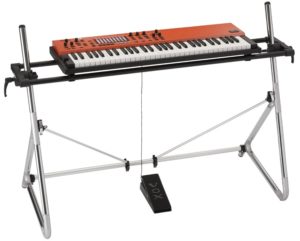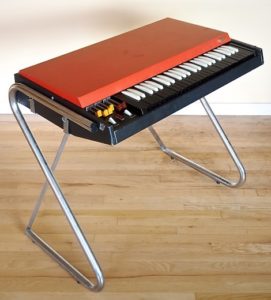Just when I’m ready to tuck into a new toy, someone — Korg — announces another pair of new keyboards for NAMM. Let’s see, the new Korg spawn now include:
- i3 Music Workstation
- XE20SP Digital Ensemble Piano
- wavestate
- SV-2 Stage Vintage Piano
- EK-50 L Entertainer Keyboard
Catch all of the action on Korg’s web site.
Meanwhile, the Kronos fanbois are gnashing their teeth and many people are still awaiting the Messiah — a full-size Arp 2600. It would be a boring world without variety, so I hope their dreams come true. [No offense intended.]
The EK-50L and the SV-2 are updates. The EK-50 L adds a more powerful amplifier (2x10W) and speakers (2x120mm double cone bass reflex) to the EK-50. The EK-50 is intended for entertainers who play small venues like coffee shops. With in-built speakers, it’s one trip from the auto to the gig. The SV-2 is an update of the SV-1 and is firmly in the middle of the stage piano market. In addition to new sounds, there is an SV-2S model with an internal K-ARRAY speaker system. The SV-2S would be great for casuals, coffee houses and such. Same idea, one trip from the car to the job.
I always liked the SV-1 sounds and its action — a tough competitor to the Yamaha CP73/CP88. Damn, the SV-2 EPs sound nice, and that German piano! Wish I had the space (and health) for a weighted action stage piano…
Korg is also reaching out to the trenches with the i3 Music Workstation. In the promotional text, I get wisps of song writing, composing, phrase library, etc. It’s a broad pitch to those who — dare I say it — would ordinarily shun an arranger keyboard.
I thought the i3 was the Krome replacement. Sure looks like it. Modern arranger keyboards are trending toward “synth workstation” anyway. The main difference is the content. Arrangers need a wide range of styles dipping into movie themes, Schlager, big band jazz, Román népi táncok, and Lord knows what else. The Yamaha Motif series distinguishes itself through its contemporary phrases (arpeggios). With the i3, Korg took the accompaniment technology from the PA series and mated it with some seriously modern sounding styles/phrases.
Ah, Korg are certainly dancing around the “A word.” It’s a shame that the word “arranger” has gotten such a negative connotation among certain musicians. Even the text for the home-oriented XE20SP refers to “automatic accompaniment”, not “arranger.” Anyone who has played a modern mid- to top-end arranger from Korg or Yamaha know the true nature of today’s machines. Yeah, some styles leave me cold. However, the playability of acoustic instrument voices is the best it’s ever been and the voices are at the same level as flagship sample-playback synths. In the case of Yamaha’s Genos Super Articulation 2 voices, the sound even exceeds the Montage flagship.
Well, there you go. We’re lucky to live in an age where manufacturers are rolling out a wide variety of electronic keyboards. I’m amazed that Behringer, for example, can issue as many different makes and re-makes as they are. They run the risk of cannibalizing their own customer base! Gosh, how many synths can the average punter really afford?
Enjoy. Peace to all.
[Hey, Korg! Somebody who is a native English speaker needs to correct the sometimes hilarious spelling errors in your specs, e.g., EK-50 L.]
Copyright © 2020 Paul J. Drongowski



